A History of the County of Hertford: Volume 3. Originally published by Victoria County History, London, 1912.
This free content was digitised by double rekeying. All rights reserved.
'Parishes: Sawbridgeworth', in A History of the County of Hertford: Volume 3, ed. William Page (London, 1912), British History Online https://prod.british-history.ac.uk/vch/herts/vol3/pp332-347 [accessed 24 April 2025].
'Parishes: Sawbridgeworth', in A History of the County of Hertford: Volume 3. Edited by William Page (London, 1912), British History Online, accessed April 24, 2025, https://prod.british-history.ac.uk/vch/herts/vol3/pp332-347.
"Parishes: Sawbridgeworth". A History of the County of Hertford: Volume 3. Ed. William Page (London, 1912), British History Online. Web. 24 April 2025. https://prod.british-history.ac.uk/vch/herts/vol3/pp332-347.
In this section
SAWBRIDGEWORTH
Sabrixteworda (xi cent.); Sebrichworde, Sebristeworda, Sabrytesworth (xii cent.); Sabrithtesworth (xiii cent.); Sabrisceworth, Sabrettesworth (xiv cent.); Sabresford or Sabrisworth (xv cent.); Sabridgeworth (xvi cent.); Sawbridgeworth (xviii cent.).
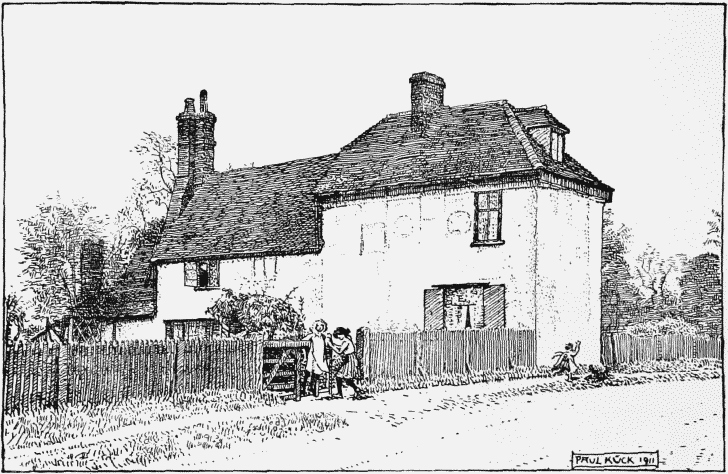
Three Mile Pond Farm, Sawbridgeworth
Sawbridgeworth is a large parish of about 6,638 acres in extent, divided from the county of Essex on the south and east by the River Stort, except for a projecting tongue of land forming the Hyde Hall estate which lies on the east of the river. On the west the boundary is formed by a small stream called Fiddler's Brook. The road from London to Newmarket passes through the parish in a north-easterly direction. To the south of the village it is known as the London Road, to the north as the Stortford Road. At Spelbrook in the north of the parish stood a turnpike gate where tolls were collected for the Hockerill trustees. (fn. 1) The road crosses the river and at the same time passes from Essex to Hertfordshire by the High Bridge, which is maintained by the county. (fn. 2) The old wooden bridge here was ruinous in 1771, and was replaced by one of brick. (fn. 3) A little to the east of the town is a railway station on the Cambridge line of the Great Eastern railway.
Sawbridgeworth lies on the London Clay. The ground reaches an altitude of about 300 ft. in the north, sloping down towards the valley of the Rib on the south and east. From the main road here a view is obtained over the river into Essex. The chief crops are wheat, barley and beans, about half the area consisting of arable land. Large quantities of saffron were once grown in Sawbridgeworth, but cornfields had replaced the saffron fields before the 15th century. (fn. 4) Saffron Field on Great Beazleys Farm and Saffron Garden, south-west of Spelbrook, now both arable, preserve the name of this ancient industry. No inclosure award has been made for Sawbridgeworth, but there were a great number of common fields in the parish. Townfield lay within the quadrangle formed by the four main streets of the town, North Field was on the north-west of the town, East Field on the south-east and on the east of the main road, Mill Fen was on the east of North Field, with the mill at its southern extremity, Eden Common adjoined the western side of the quadrangle, whilst White Post Field, Great Sayes Field, Manfield, Hoestock, Claveley, Bean Field, Brick Field, Belcomstead, Writhingales, Henley Hearn, Great Hollingson, Sidcup, Kingsey, and many other commons appurtenant to the numerous manors covered the greater part of the parish. (fn. 5) All these fields are now in separate ownership. Other field-names in Sawbridgeworth mentioned in 1838 are Goggles and Further and Hither Glices on Stonard's Farm, Numums Field on Redrick's Farm, Rainbow Field and Parrot's Field on Rowney Farm, White Moor, White Field, and Mountain Mead on Blunt's Farm, Great and Little Battles (arable) and Battle Wood, part of Gilston Glebe. (fn. 6) Beanfield, now called Bell Mead, was left to the church for the purpose of growing beans to be strewn on the floor of the church.
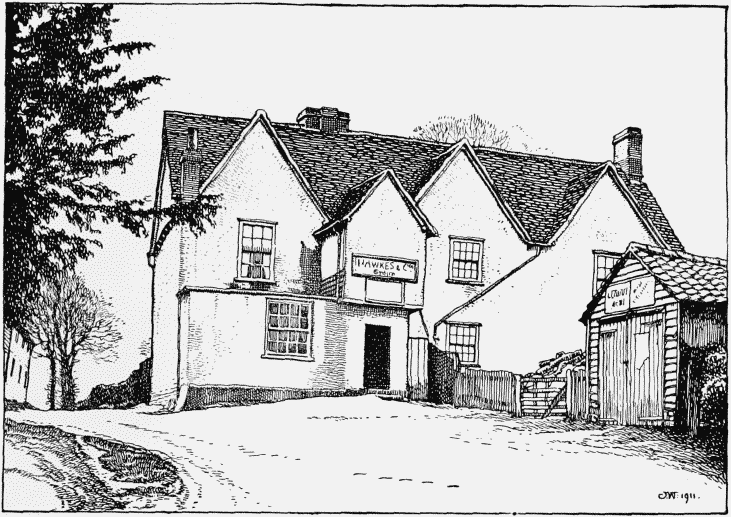
Sawbridgeworth: Hand and Crown Inn
An interesting agricultural enterprise was begun here by the late Mr. John Prout. In 1861 he acquired Blunt's or Blount's Farm, consisting of about 450 acres on the chalky boulder clay, and there applied the results obtained from the Rothamsted experiments to practical farming. The farm was laid out for the production of a continuous series of corn crops, and for this purpose was divided into fields of about 50 acres, each of which was dressed with chemical manures and cultivated by steam ploughs. Mr. John Prout carried on the farm until 1894, when he was succeeded by his son Mr. William Prout. (fn. 7) The nursery gardens of Messrs. Rivers & Sons date back to about 1720, when they were established by John Rivers, a native of Berkshire. Mr. Thomas Rivers, who succeeded to the business in 1827, formed his famous collection of roses here. He also introduced the 'Early Rivers' plum, which has done good service to English gardeners by extending the native fruit season. His son, Mr. T. A. H. Rivers, is the present head of the firm.
The town of Sawbridgeworth lies on the east of the parish near the Stort and on the London Road. It forms a parallelogram in shape, Barkers Lane (now called Station Road) and Cock Street (or Bell Street, as it is now generally called) running at right angles to the London Road (here called the Cambridge Road) and Knight Street forming the fourth side of the figure. The Newtown lies along Barker Lane, which is the north side of the parallelogram. The names Knight Street and Cock Street are as old at least as the 16th century. (fn. 8) A cross called Knight's Cross was apparently situated in the former street, whilst from it a road led to the Two Crosses (Le Toocrowches) which were in Sayesfield. (fn. 9) Church Street, a continuation of Cock Street, leads to the parish church of St. Mary. To the south-west of the church is the Square, which was once the market-place. There is now no market, but two fairs are still held on the Fair Green, one in April and the other in October. The vicarage lies to the south of the church. In the London Road is a Congregational chapel representing a dissenting community dating back as far as 1669. In 1814 a chapel for Independents and Baptists was certified at Sawbridgeworth; this was superseded by a new chapel built in 1862. (fn. 10) There are two elementary schools, one to the north and the other to the south of the church. To the north of the town is a corn-mill, probably occupying the site of the mill mentioned in the Domesday Survey. The eastern part of the town is for the most part occupied by malt-houses, malt-making being the chief industry.
A number of old houses still remain in and about the town. The Church House, situated at the churchyard gates, is an old building with good beams. This was formerly church property, and was used as a workhouse and afterwards as a school. It has lately been bought and given for a church house (see Charities, no. 1). (fn. 11) On both sides of Bell Street are several 17th-century cottages built of timber and brick coated with cement and having projecting upper stories. A cottage on the south side has its original brick chimneys. There are also some pleasing 18th-century houses in the town. On the road to High Wych is the Hand and Crown Inn, a 16th-century gabled building of two stories which has been added to in the last century. It is of timber and plaster with a projecting upper story and a porch. There is an original window on the south side. On the Stortford Road, a little way past North End, is Three Mile Pond Farm, a 17th-century pargeted house. Clay Lane (now called West Road), leading west from the town, has also several old farm-houses. Great Beazleys, on the north of it, is now a small cottage, but incorporates a fragment of an earlier 17th-century timberframed farm-house of two stories. On an interior beam is cut I. R. 1612. To the east of the house is an old barn built of sun-dried mud bricks. Crump's Farm, on the same side of the road, is a red brick building of two stories and attics, with the inscription K/IA 1628 over the front door. Little Beazleys, on the south side, is a two-storied building with thatched roof and the date 1662 on the north front. Due north of Great Beazleys is Tharbies, now a modern farm-house occupied by Mr. J. L. Kirkby. Close to the house is a small square dove-house, timberframed. The lower part is weather-boarded and the upper part covered with lath and plaster and ornamented with square flush panels. The pyramidal roof is tiled and has two small gables at the apex. About half a mile north of Tharbies there was an old moat marked on the ordnance map. This has been recently filled up by Mr. Kirkby and ploughed over.
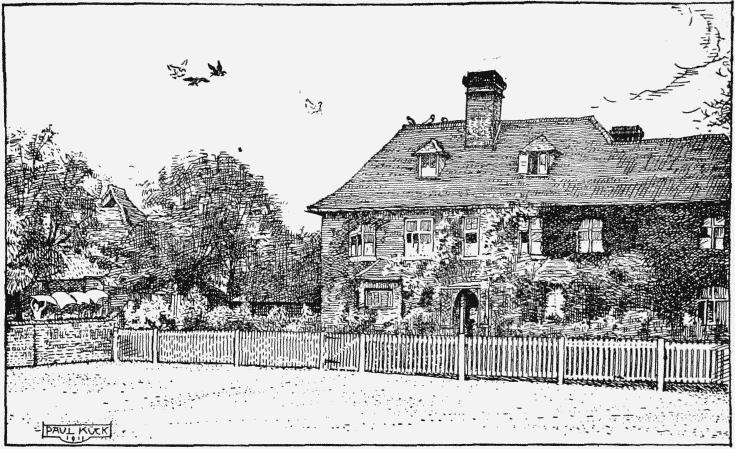
Tharbies, Sawbridgeworth
Successive grants of market (see manor) have never resulted in making Sawbridgeworth a commercial centre. Probably the neighbourhood of a flourishing market at Bishop's Stortford interfered with the success of the Sawbridgeworth market. From the number of inhabitants who contributed to the various local assessments, however, it would seem that the town has always been a thriving one, and in the 15th century there is record of burgage tenure there (see manor). In the 14th century the parish was divided for fiscal purposes into the districts of Cherchegate Street, Pyshoo Street, Nethynhoo, Westwood Street, Frere Street, Mynton Street, Smith Street, Chames Well Street, Haleynes Grene (Allen's Green), Brod Street, Spelbrok and Northende. Clutterbuck, writing in 1827, mentions that the parish contained three hamlets. Town Quarter, Spelbrook Quarter and Highway Quarter. In 1901 part of the parish of Sawbridgeworth was made into a new civil parish and urban district. The town is now governed by an urban district council of twelve members.
The hamlet of High Wych lies on the road from Sawbridgeworth to Gilston, about half a mile southwest of Sawbridgeworth. It was formed into an ecclesiastical district in 1862. (fn. 12) St. James's Church stands on the north of the road. To the south of the church is the school, and on the other side of the road is the vicarage. Spelbrook (fn. 13) is another hamlet on the main road to the north of Sawbridgeworth. The school, which was built in 1891, is used for services on Sunday.
There is little of antiquarian interest in the history of the parish of Sawbridgeworth. Only one discovery of prehistoric remains has been made, that of two cinerary urns containing ashes or calcined bones found about 300 yards north of the Stort and 170 yards east of the high road from Sawbridgeworth to Harlow and fragments of pottery of the RomanoBritish period. (fn. 14) Historically Sawbridgeworth owes its interest to its manors, which furnish an unusually complete example of the processes of subinfeudation (see below).
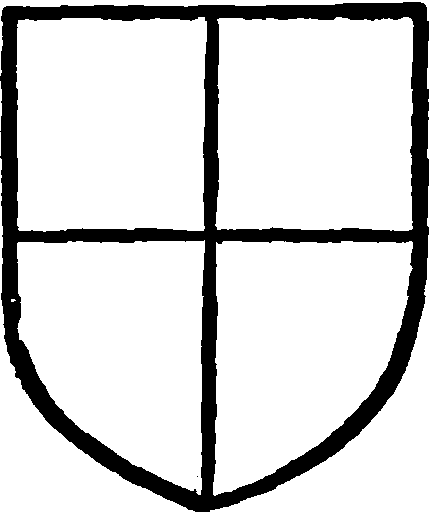
Mandeville, Earl of Essex. Quarterly or and gules which arms were assumed and borne by the Says.
MANORS
Sawbridgeworth
The manor of SAWBRIDGEWORTH, assessed in 1086 at 24½ hides and consisting of land for forty ploughs, meadow for twenty plough-teams, pasture for the live stock, woodland for 300 swine and a mill then held by a tenant, must have comprised the whole of the present parish. In the reign of Edward the Confessor it had been held by Asgar the Staller, and after the Conquest it was acquired by Geoffrey de Mandeville, who held in 1086. (fn. 15) William de Mandeville, son and successor of Geoffrey, mortgaged the manor to the Crown, and it was granted by Henry I to Eudo Dapifer. (fn. 16) Geoffrey de Mandeville the younger, however, on obtaining a renewed grant of the earldom of Essex (conferred originally on his father Geoffrey de Mandeville, son of William, in 1156), also received all the lands held by Geoffrey his great-grandfather, including Sawbridgeworth, with a release of the mortgage held by Henry I on the manor. (fn. 17) The lands were to be held with soc, sac, toll, team and infangentheof. Geoffrey the second Earl of Essex died in 1166, when he was succeeded by his brother William de Mandeville, third Earl of Essex. He died in 1189, leaving no issue, and Sawbridgeworth passed to his aunt Beatrice de Say, daughter of William de Mandeville, and on her death to her younger son Geoffrey de Say. From this family the manor (reduced by 74 librates from its extent in 1086, see below under Pishobury) took the name of SAYESBURY.
In 1222 Geoffrey de Say, son of the last-mentioned Geoffrey, received the grant of a market to be held at Sawbridgeworth on Saturday. (fn. 18) By another grant the following year the day was changed to Friday. (fn. 19) William de Say, son and successor of Geoffrey, probably inclosed the park, for in 1237 he was allowed ten bucks from the king's forest of Essex to place in his park of Sawbridgeworth. (fn. 20) In 1245 he obtained a licence for free warren in his manor. (fn. 21) The extent taken at his death in 1272 mentions the park and warren. (fn. 22) William de Say, his son and successor, was presented before the commissioners of Edward I for having appropriated free warren on alien fees and on the lands of his tenants. (fn. 23) He claimed the liberties of gallows, view of frankpledge, assize of bread and ale, pillory, tumbrel and prison at Sawbridgeworth as belonging to the honour of Mandeville and exercised by his ancestors. These were allowed him. (fn. 24) William de Say died in 1295. (fn. 25) Geoffrey de Say, his son, was summoned to Parliament as Lord Say from 1313. In 1306 he obtained a renewal of the Friday market granted in 1223 and a grant of a yearly fair on the vigil and feast of the Nativity of the Virgin Mary (8 September). (fn. 26) He died in 1322 (fn. 27); his wife Idonia survived him and received a grant of the manor for life from her son Geoffrey. (fn. 28) Geoffrey the younger died in 1359 (fn. 29) and was succeeded by his son William de Say. The extent of the manor taken at his death in 1375 gives a messuage with garden, 500 acres of arable land, 15 acres of meadow, 20 acres of pasture and 100 acres of wood. The rents from customary tenants included 1 lb. of wax and 3 gross of arrows. (fn. 30) John son and heir of William died a minor in 1382. (fn. 31) The manor passed to his sister Elizabeth, who made a settlement on herself and her first husband, Sir John de Falwesle, in 1388, (fn. 32) and on herself and second husband, Sir William Heron, in 1396. (fn. 33)
Elizabeth Lady Say died without issue in 1399. Heron, who was summoned to Parliament as Lord Heron from 1393, and is generally considered to have been styled Lord Say, (fn. 34) obtained many of his wife's estates, including Sawbridgeworth. Maud Bosenho, daughter of Elizabeth de Alden, one of the co-heirs of Elizabeth de Say, quitclaimed her right in the manor to him in 1401. (fn. 35) He died seised in 1404, (fn. 36) his nephew John, son of his brother John, being his heir. The extent taken at his death mentions that the capital messuage was then ruinous. Sir John Heron died in 1420 and was succeeded by his son John, (fn. 37) who in 1460–1 settled Sawbridgeworth on himself and his wife Agnes in tail with contingent remainder to Brian Rowcliff and other feoffees. (fn. 38) John Heron died in 1468 without issue. (fn. 39) A few months afterwards the feoffees conveyed the manor to Sir John Say, who died seised of it in 1478. (fn. 40) His son Sir William Say died in 1529, leaving two daughters, of whom Mary wife of Henry Bourchier, Earl of Essex, inherited Sawbridgeworth. (fn. 41) Their daughter and heir Anne, wife of William Lord Parr, had livery of Sawbridgeworth on her father's death in March 1539–40. (fn. 42) Lord Parr, who was created Earl of Essex in 1543 and Marquess of Northampton in 1547, was attainted in 1553 (fn. 43) and Sawbridgeworth came to the Crown.
In 1556 a lease of the manor for forty years was made to trustees for the benefit of Anne Lady Bourchier, whom Lord Parr had repudiated as his wife in 1543. (fn. 44) During her tenure a suit in Chancery was brought against her by copyholders of the manor whom she had turned out of their tenements on the plea that the lands had been granted by her father, who held the manor for life only. Judgement was given for the plaintiffs in 1565. (fn. 45) Anne died in 1571 without legitimate issue and the manor escheated to the Crown. In January 1572–3 the farm called Sayes Park was leased to William Lord Burghley, (fn. 46) and in 1609 a lease was made to Robert Earl of Salisbury (son of Lord Burghley) for the lives of himself, his son William Cecil and his daughter Frances Cecil. (fn. 47) The earl died in 1612 and his son in 1668. In February 1613–14 the manor and park were granted in fee to Lionel Cranfield, (fn. 48) a son of Thomas Cranfield of London. He filled successively the offices of Master of the Requests, Keeper of the Great Wardrobe and Master of the Court of Wards and Liveries, and in 1621 was made Lord Cranfield of Cranfield, co. Bedford. From 1621 to 1624 he was Lord High Treasurer and was created Earl of Middlesex in 1622. In May 1624, however, he was convicted of mismanagement and sentenced to lose all his offices and fined £50,000. (fn. 49) He seems to have surrendered the manor to the king, who in 1632 granted it with Sayes Park, the manor of Pishobury (except the park), Sawbridgeworth Mills and the rents of land called Alexander, late of Edward Leventhorpe, and of the manor of Glasmonhall, co. Cambridge (viz. 1 lb. of pepper and 1 lb. of corn from the first and I red sparrow-hawk from the second) to Arthur Brett and Nicholas Harman. (fn. 50) They in 1635 joined with the earl in conveying the manors to Thomas Hewett, (fn. 51) created a baronet in 1660, who resided at Pishobury. (fn. 52) He died in 1662 and was succeeded by his son Sir George Hewett of Pishobury, who for his services in Ireland was made Baron of Jamestown, co. Longford, and Viscount Hewett of Gowran, co. Kilkenny, in 1689. He died without issue in 1689. (fn. 53) His heirs were his four surviving sisters, Elizabeth wife of Sir Richard Anderson, bart., Arabella wife of Sir William Wiseman, Margaret wife of Sir Edward Farmer, and Mary wife of Sir Charles Crofts Read. (fn. 54)
In the same year Sir Charles and Lady Read settled their quarter of the manor of Sayesbury, of the farm called Sayes Park, closes called Church Close and Sayes Garden, a coppice called Sayes Coppice, the two water-mills called Sawbridgeworth Mills, one a corn-mill and the other a fulling-mill, and the manor of Pishobury on their three youngest children, Jane wife of Anthony Wroth, Bridget afterwards wife of Thomas Tarver, and Thomas. (fn. 55) In the division of Lord Hewett's lands made in 1691 the whole of the Sawbridgeworth estate seems to have been settled on Lady Read (fn. 56) and to have descended to her three younger children. Jane and Anthony Wroth conveyed their third about 1700 to William Betts, (fn. 57) and Bridget and Thomas Tarver their share some years later to Thomas Betts. (fn. 58) In 1709 Thomas and Bridget conveyed a sixth (their share after the death of Bridget's brother Thomas) to Robert Colman. (fn. 59) Each of the first two of these conveyances, and possibly the third, was in trust for Ralph Freeman. (fn. 60) Whether he acquired the remaining sixth of the lands is uncertain, as in 1709 Anthony Wroth settled it to his own use. (fn. 61)
The manors descended with Hamells in Braughing (q.v.) to Philip Yorke, third Earl of Hardwicke, (fn. 62) who, according to Clutterbuck, sold them in 1823 to Rowland Alston of Harrold House, co. Beds. (fn. 63) In 1851 they were purchased by John Hodgson of Gilston, (fn. 64) since which date they have descended with Gilston (q.v.), Mr. A. S. Bowlby being the present lord of the manors.
The manor-house of Sayesbury was long ago pulled down, and the demesne lands have been for the most part divided up into farms. (fn. 65) Sayes Park Farm, Park Field a large field to the west of Sayes Park Farm, Corn Park to the south of this and Grass Park to the north of it preserve the name of the ancient manorial park, and Dovehouse Field of the manorial dovecote. (fn. 66)
Some accounts for the manor at the end of the 13th century show that there were 8 virgates which paid ox-silver and sheep-silver to the lord (cf. Pishobury). The 'gavelerth,' of which each acre paid 6d., is also mentioned. (fn. 67) Burgage tenure is mentioned in a rental of 1433 of the lands of John Heron (15th century), where the rent of assize within the borough of Sawbridgeworth is said to amount to £4 9s. 6d. and the rent within the 'patria' to £3 17s. 9d. (fn. 68) A pedigree of the villeins of the manor taken by inquisition apparently in the 13th century (fn. 69) is printed by Professor Vinogradoff. (fn. 70)
Pishobury
The manor called SAWBRIDGEWORTH down to the end of the 13th century, and after that PISHO or PISHOBURY (Peyshoo, Pyssoubery, xiii cent.; Pyshobury, Spisshou, xiv cent.; Pisshou, Pyshowe, xv cent.; Pyssowe, Pisshebury, Pishoo, xvi cent.; Pishebury, xvii cent.), originated in a grant of 74 librates of land at Sawbridgeworth, which Geoffrey de Mandeville the elder (ob. 1144) made to Warin and Henry Fitz Gerold, to hold by the service of one knight for each 20 librates. (fn. 71) Grants were made by Warin and Henry to Bury St. Edmunds and Reading Abbey (see Tednambury and Groves); the remainder of the land formed the manor of Pishobury. Henry, who survived his brother, left two sons, Warin and Henry. Margaret, daughter and heir of Warin, married Baldwin de Redvers, Earl of Devon, whom she survived, and secondly Falkes de Breauté, who forfeited in 1224. The manor was granted to Margaret during the king's pleasure. (fn. 72) In 1248 Margaret levied a fine with William de Say, by which it was agreed that William and his heirs were to have free warren throughout the vill of Sawbridgeworth including Margaret's demesnes, the warren to be kept by William's warrener, whilst Margaret and her heirs were to have free chase in her fee with dogs, birds or nets, and free fishery in the river where it adjoined her lands. (fn. 73) Baldwin de Redvers, Earl of Devon, son and heir of Margaret, died in February 1244–5 (fn. 74) and his son Baldwin in 1262, (fn. 75) leaving no issue. His widow Margaret had seisin of the manor. (fn. 76) She married Roger Aguilon, (fn. 77) and held the manor until her death in 1292. (fn. 78) It then passed to Isabella Countess of Albemarle, sister of Baldwin, (fn. 79) who died in 1293, having survived her only daughter Avelina, wife of Edmund Earl of Lancaster. Her cousin Hugh de Courtenay, great-grandson of Mary daughter of William de Redvers (father of the first-mentioned Baldwin), was her heir, but Warin Lisle (de Insula) had a grant of the issues of the manor in 1294 to hold until Hugh came of age, (fn. 80) and in 1310 his son Robert successfully claimed the manor against Hugh de Courtenay by descent from Henry the brother of Warin above mentioned (son of Henry Fitz Gerold), whose daughter Alice married Robert Lisle of Rougemont and was father of Robert, father of Warin, father of the plaintiff. (fn. 81)
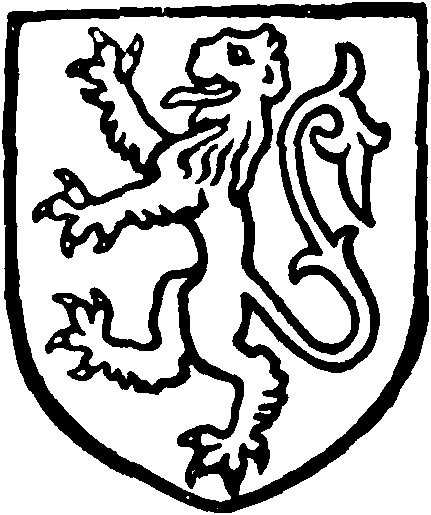
Redvers. Or a lion azure.
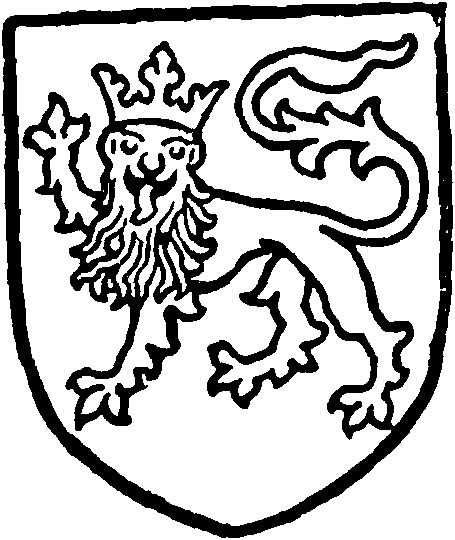
Lisle. Gules a leopard argent crowned or.
Robert Lisle was summoned to Parliament as Lord Lisle from 1311. Shortly before his death (in January 1342–3) he took religious orders, having previously in 1339 granted Pishobury with other manors to his daughters Alice, wife of Sir Thomas Seymour, and Elizabeth Peverel for life, with remainder to his son John, who quitclaimed to his sisters. (fn. 82) This grant was apparently made by Robert for the performance of certain alms. (fn. 83) In 1343, however, John obtained from Alice and Elizabeth a release of the manor for thirty years, with the exception of certain premises—viz. the house on the left-hand side within the second gate, which contained two chambers for habitation, and the park of Gedelesho, which belonged to the manor, John retaining 12 acres of underwood yearly with profits from the land called Vodeleye and housbote and heybote for the manor, the keeper of Gedelesho Wood to be chosen with the assent of both parties and to have his robe from Alice and his livery of corn, &c., from John. (fn. 84) John Lord Lisle died seised of the lease in 1356. (fn. 85) After his death Alice Seymour surrendered Pishobury to his son Robert, who was to assist her in the foundation of charities begun by Sir John Lisle for the soul of his father. (fn. 86) In 1368 Robert Lisle granted his knights' fees and the courts held for his tenants at Walbrook and Farningho, co. Essex, to the king. (fn. 87) This transaction has led to the inference that he had no legitimate issue, but one pedigree gives him a son William, (fn. 88) and a William Lisle granted Pishobury in March 1392–3 to Richard first Lord Scrope of Bolton, (fn. 89) this transaction being followed in 1394 by a quitclaim from Sir Robert Lisle. (fn. 90)
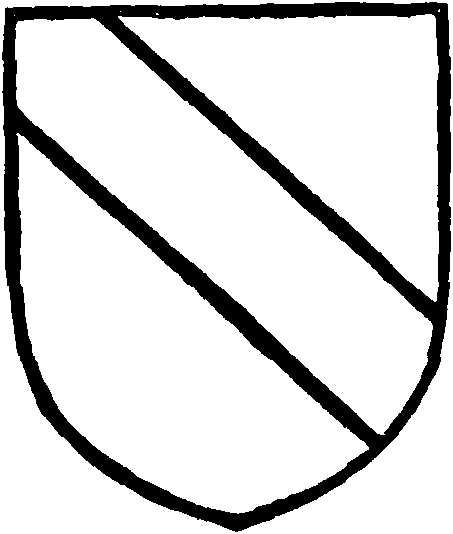
Scrope of Bolton. Azure a bend or.
In 1393 Lord Scrope had licence to endow a chantry in his chapel in Bolton Castle with a rent of £33 6s. 8d. from the manor. (fn. 91) He died in 1403, his will being dated at Pishobury in 1400. (fn. 92) His son and heir Roger second Lord Scrope died in the same year. Richard third Lord Scrope, son of Roger, mortgaged the manor, and it was held by mortgagees at the time of his death in 1420. (fn. 93) His son Henry fourth Lord Scrope died seised in January 1458–9, (fn. 94) and the manor was held successively by his son John fifth Lord Scrope, who died in 1498, (fn. 95) and by Henry sixth Lord Scrope, son of John, who died in 1506. Henry, the seventh lord, received an intimation through Cromwell in 1532 that the king wished to have the manor to annex it to the honour of Hunsdon. (fn. 96) Negotiations were begun, but the transaction was not completed when Lord Scrope died in December 1533. The exchange was effected by his son John eighth Lord Scrope in March 1533–4. (fn. 97) An extent of the manor of about this date, probably when it came into the king's hands, describes a park nearly 2 miles in circumference, well wooded, with game, deer and coneys, and a lodge on one side for the keeper, a moated house within the park, then somewhat fallen into decay, and a stable in good repair, with room for twenty horses. (fn. 98)
In 1534 Henry VIII granted the manor to his queen Anne Boleyn. (fn. 99) The Sawbridgeworth mills, which had been leased by Henry Lord Scrope to Robert Noddes, were in 1544 leased to Oliver Rigbye of Waltham Holy Cross. (fn. 100) In 1547 Edward VI granted the manor with Sawbridgeworth Mill and Pishoo Park to Sir Thomas Cawarden, Gentleman of the Privy Chamber, (fn. 101) who a few months later alienated it to Sir Wimund Carew of Blechingley. (fn. 102) Thomas son of the latter conveyed it in 1555 to Thomas Mildmay, (fn. 103) from whom it descended to his second son Walter Mildmay, (fn. 104) who was holding in 1576. (fn. 105) Rather later (about 1598) the manor was seized into the hands of the queen in satisfaction of a sum of £2,232 for which Sir Wimund Carew had been in debt to the Crown, (fn. 106) and was leased to Thomas Monke. (fn. 107) Mildmay died in February 1606–7, when the debt was still unliquidated, but Sir Thomas Mildmay, his son, was holding in 1610, (fn. 108) and in 1611 conveyed the manor, with the two mills and other appurtenances, to Lionel Cranfield, (fn. 109) who also acquired Sayesbury. The rest of the descent of the two manors is treated under Sayesbury (q.v.).
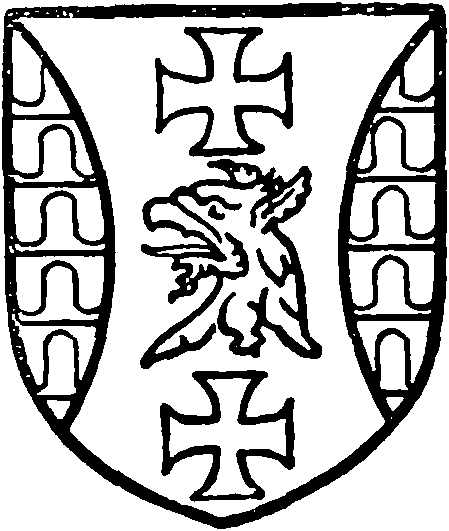
Charrington. Gules a griffon's head razed between two crosses formy or with two flaunches vairy or and azure.
After the death of George Lord Hewett in 1689 the capital messuage of Pishobury was limited to his sister Lady Arabella Wiseman for a thousand years. (fn. 110) She sold it, according to Clutterbuck, to William Gardiner, (fn. 111) from whom it came to Edward Gardiner and then descended with Shingehall and Mathams (q.v.) to Rowland Alston. He sold it in 1847 to Francis Ede, after whose death in 1849 it was acquired by Mr. B. B. Colvin of Waltham, and his executors conveyed it in 1865 to Andrew Caldecott. It was bought from Caldecott by the late Mr. Francis W. Buxton, who sold it later to Col. F. Charrington, C.M.G., the present owner and occupier. (fn. 112)
The house, which lies within Pishobury Park immediately to the south of the town, is said to have been built in 1585 by Sir Walter Mildmay. Chauncy describes it as having 20 acres of ground on the east side then used as a paddock for deer, a bowling green in front raised 5 ft. high and inclosed with a brick wall, and two avenues about 4 furlongs in length from the house to the road. (fn. 113) Two of the avenues were removed and the third destroyed by Jeremiah Mills under the advice of 'Capability Brown,' who superintended the making of an ornamental lake. (fn. 114) The house was destroyed by fire and practically rebuilt by James Wyatt in 1782, who utilized some of the old material. It is a square brick building of three stories with embattled parapet, and a central courtyard, which is now roofed in. In the entrance hall is some 16th-century oak panelling. The dining room is panelled and has a carved stone fireplace with an iron fireback bearing the Stuart royal arms and dated 1635. Above is a carved oak overmantel of about the same date. In the servants' hall are a 16th-century fireplace and panelling. The stables and barns on the south of the house date from about 1600.
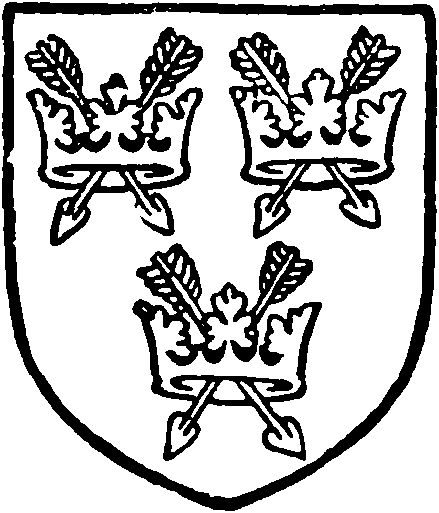
Bury St. Edmund's Abbey. Azure three crowns or each thrust through with a pair of arrows or saltirewise.
Tednambury, Tedenhambury, or Tedenhoebury
The manor of TEDNAMBURY, TEDENHAMBURY, or TEDENHOEBURY (Tydenham, (fn. 115) xiv cent.; Tydenhoubery, Tuddenhoburye, xvi cent.; Tuddinghoebury, xvii cent.), which lies on the north-east of the parish, was formed by 6 librates of land given to the monastery of Bury St. Edmunds (of which the name seems to be a corruption) by Warin Fitz Gerold (see under Pishobury) in the first half of the 12th century. (fn. 116) In the reign of Edward I the Abbot of St. Edmund's claimed gallows, view of frankpledge, and assize of bread and ale at Sawbridgeworth as among the liberties conferred on the abbey by Canute. (fn. 117) These were allowed him. The manor remained with St. Edmund's until the Dissolution, when the farm was worth £11 10s. (fn. 118)
In 1544 the manor was granted to Sir Henry Parker, Lord Morley, together with woods of 9½ acres called Sperthes Grove, Walters Grove and Patmore's Grove. (fn. 119) Lord Morley was succeeded in 1555 by his grandson Henry, who died seised in 1577, (fn. 120) when it descended to his son Edward Lord Morley, and at his death in 1618 to his son William Lord Morley and Mounteagle of Gunpowder Plot fame. (fn. 121) He died in 1622 (fn. 122) and his son Henry Lord Morley in 1655. Thomas Lord Morley, son of the latter, conveyed it in 1657 to Robert Brudenell and others, (fn. 123) apparently trustees for Thomas Lindsey, (fn. 124) whom Chauncy gives as the purchaser. Lindsey had two daughters, Grace, who married Richard How, and Elizabeth, who married George Hocknell. (fn. 125) The manor was divided between them, but seems eventually to have become the property of the heirs of Grace. Her son Richard How died without issue (fn. 126); his brother John was holding the manor in 1738, (fn. 127) in which year he conveyed it to William Taylor. (fn. 128) William Taylor How was in possession in 1756. (fn. 129) He died before 1779, leaving five sisters and co-heirs, Jane, Catherine and Anne Taylor, Elizabeth wife of James Stillingfleet and Sarah wife of Savile Read. (fn. 130) According to Clutterbuck it was assigned to Sarah and Savile Read, but was devised by the latter, who survived, to the three unmarried sisters, and was sold by Anne, who outlived the others, to Mrs. Rose Milles in 1799. (fn. 131)
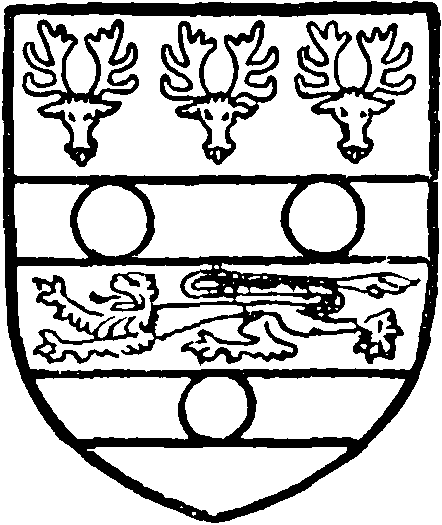
Parker, Lord Morley. Argent a lion passant gules between two bars sable with three harts' heads caboshed sable in the chief and three bezants on the bars.
Tednambury descended with Shingehall and Mathams (q.v.) to Rowland Alston, who sold in 1842 to William Bigg of London. After his death in 1868 it was conveyed by trustees to Augustus Smith of Upper Norwood. (fn. 132) In 1867 John Hodgson of Gilston bought it. (fn. 133) It now belongs to Sir Walter Gilbey.
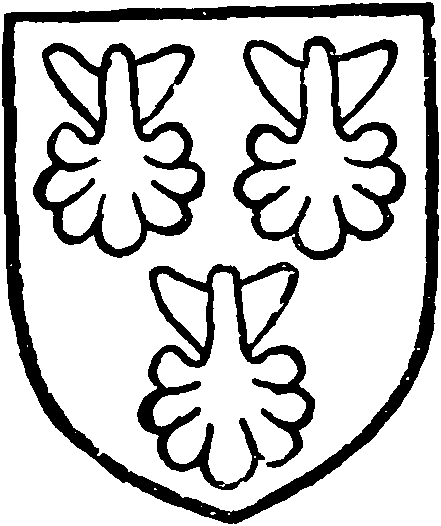
Reading Abbey. Azure three scallops or.
Groves
The manor of GROVES comprised the land given by Henry Fitz Gerold (see Pishobury) to the abbey of St. Mary, Reading, probably in the second half of the 12th century. (fn. 134) In 1287 the Abbot of Reading claimed assize of bread and ale, infangentheof, utfangentheof, chattels of fugitives and felons, and waif in his lands at Sawbridgeworth as among the liberties granted him by Henry I. (fn. 135) After the Dissolution the manor was granted in 1544 to William Gooding or Goodwin (fn. 136) of Writtle, co. Essex. He sold it in 1549 to Robert Gooday. (fn. 137) It descended to Thomas Gooday, who conveyed it in 1571 to Robert Hirst. (fn. 138) The latter died seised in 1548, his heir being his nephew Henry, son of his brother John. (fn. 139) Henry Hirst sold in 1594 to John Duke, (fn. 140) who held it until his death in 1606. (fn. 141) In the inquisition taken at his death the manor is called Sawbridgeworth alias Groves, the first time that the latter name appears. Robert Duke, his son, is said by Chauncy to have granted the manor in 1628 to his own son John Duke, rector of High Roding, co. Essex, who married Joyce Bennet. (fn. 142) Robert son of John sold the manor in 1665 to his mother Joyce, (fn. 143) who in 1671 conveyed it to Thomas Rogers. (fn. 144) John Rogers, son of Thomas, (fn. 145) sold it in 1693 to Edmund Godwin (fn. 146) of Eastwick, and from the latter it was bought in 1702 by Anne Mary Godfrey, widow. (fn. 147) It descended to Peter Godfrey, and a Godfrey was holding when Salmon wrote (1728). In 1742 it was in the possession of Eliott Taylor, (fn. 148) of whose heirs it was bought by Thomas Nathaniel Williams, the owner in 1823. (fn. 149) It was sold, according to Cussans' descent, to Jones De'Ath by Williams's trustees in 1844. (fn. 150) Later it was acquired from the De'Ath family by Mr. E. B. Barnard, who sold it to Mr. Silva, the present owner. The house called Grove Lodge lies within a small park a little to the north-west of High Wych.
Shingehall alias Shinglehall alias Shingey and Mathams
The manors of SHINGEHALL alias SHINGLEHALL alias SHINGEY and MATHAMS seem to have been originally two separate properties which became amalgamated in the hands of the Matham family, from whom the second manor took its name. They were evidently formed by subinfeudation from the Mandeville manor, and were held of the honour of Mandeville. This descended not to the Says (as did the manor of Sayesbury) but to the Earls of Essex, descendants of William de Say, eldest son of Beatrice de Say, whose daughter Beatrice married Geoffrey Fitz Piers, created Earl of Essex in 1199, their son Geoffrey taking the name of Mandeville. (fn. 151) Through Maud, sister and heir of William de Mandeville, it passed to the Bohuns, Earls of Hereford, and eventually came to the Crown by the marriage of Mary de Bohun with Henry IV and was annexed to the duchy of Lancaster. (fn. 152) The manor of Mathams was the holding of a family of that name who had lands in Sawbridgeworth at an early date. A John de Matham appears as a witness to deeds at the end of the 13th century. (fn. 153). He had a daughter Christina (fn. 154) and a wife Isabel. John and Isabel were apparently both dead by 1304, when a conveyance took place of a piece of land charged with an annual rent of 2d. for celebrating two anniversaries for their souls. (fn. 155) Geoffrey de Matham (fn. 156) was holding lands in Sawbridgeworth in 1268. (fn. 157) He claimed view of frankpledge in 1278, (fn. 158) as held by his ancestors since the time of the Conquest. About 1301 he acquired the lands called 'La Syngledehall' from Geoffrey de la Mare, (fn. 159) and henceforth the two manors descend together. He seems to have been succeeded by Sampson Matham. (fn. 160) In 1365 Sampson and his wife Margaret granted all their lands in Sawbridgeworth to John Blode, a London fishmonger, to hold during their lives. (fn. 161) Hamelin son of Sampson succeeded to the property in Sawbridgeworth, and died seised of a messuage and 240 acres of land, 10 acres of meadow, 7 acres of pasture, 4 acres of wood and 16s. 4d. rent there in 1382. (fn. 162) He left two daughters, Elizabeth and Margaret, (fn. 163) who as Elizabeth wife of John Thorpe and Margaret wife of John Michell, a fishmonger of London, conveyed the manor called Mathams and lands in Sawbridgeworth to John Leventhorpe by fine of Hilary, 1413–14. (fn. 164)

Leventhorpe of Shinglehall, baronet. Argent a bend gobony gules and sable.
John Leventhorpe was member for the county in 1413 and 1422. (fn. 165) He died in 1433 and was buried at Sawbridgeworth. (fn. 166) His son John Leventhorpe, also member for Hertfordshire in 1467, (fn. 167) had a grant of free warren in Sawbridgeworth, Thorley and Stortford in 1439. (fn. 168) In 1447 he obtained a grant of a market on Wednesdays and two fairs on the eve, day and morrow of the feasts of St. Denis and St. George the Martyr, and licence to inclose 400 acres of land, 40 acres of meadow and 80 acres of wood in Sawbridgeworth and Thorley for a park. (fn. 169) On his death in 1484 he was succeeded by his son Thomas, aged sixty, (fn. 170) who held the manor until his death in 1493. (fn. 171) John, his son, who was Sheriff of Hertfordshire in 1509, (fn. 172) died in 1511, when Shingehall and Mathams descended to his son Thomas, (fn. 173) who in 1517 received a confirmation of the grant of market, fair, and park made in 1447. (fn. 174) He died in 1527, (fn. 175) his son Edward in 1551, (fn. 176) and his grandson Edward in 1566. (fn. 177) John son of Edward was knighted at Theobalds in 1603, was Sheriff of Hertfordshire in 1593–4 and 1607–8, and was created a baronet in 1622. He married Joan daughter of Sir John Brograve of Hamells in Braughing and died at Sawbridgeworth in 1625. (fn. 178) Thomas, his second but eldest surviving son, succeeded. He died in 1636 and was buried at Sawbridgeworth. (fn. 179) His son John, a minor at his father's death, (fn. 180) died of smallpox in 1649, when the property passed to his brother Sir Thomas Leventhorpe, who had no male issue. Sir Charles Leventhorpe, his uncle and male heir, rector of White Roding, co. Essex, succeeded to the title in 1679, but the manors passed to Mary daughter of Sir Thomas Leventhorpe, who married John Coke of Melbourne, co. Derby. (fn. 181)
Thomas Coke, son of John and Mary, sold Shingehall and Mathams to Ralph Freeman, D.D., (fn. 182) who conveyed them in 1755 to Edward Gardiner. (fn. 183) His daughter and heir Rose married Jeremiah Milles, and they were holding the manor in 1781. (fn. 184) Jeremiah died in 1797, whilst Rose Milles suffered a recovery of the manor in 1803, (fn. 185) and survived until 1835. (fn. 186) Rose, her daughter and co-heir, married Rowland Alston, (fn. 187) who acquired Sayesbury and Pishobury, after which the manors descend together (see under Sayesbury).
There is a homestead moat at Shingehall close to Trim's Green. The house is now a farm occupied by Mr. F. J. Lukies. The names Park Field and Mill Field on this estate (now both arable) point to the ancient park and mill. (fn. 188) On the north-west a moat marks the site of the old manor-house of Mathams.
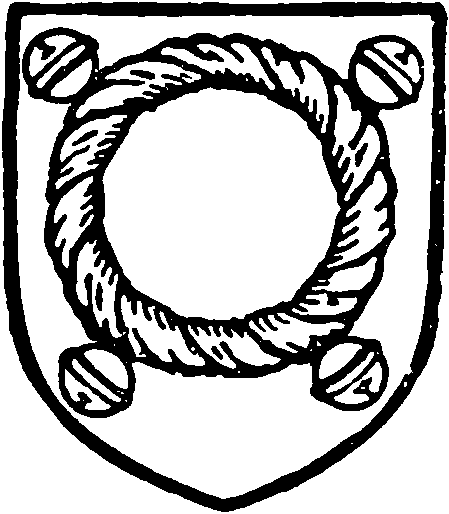
Jocelyn, Earl of Roden. Azure a circular wreath twisted argent and sable with four hawks' bells or affixed thereto.
Hyde Hall
The manor of HYDE HALL, which occupies the tongue of land on the east of the Stort, is an interesting example of an estate which has remained in the same family from the date of its first appearance until the present day. It appears first under the name of The Hyde and was held of the Earls of Essex, chief lords of the fee. (fn. 189) Early in the 13th century it was in the tenure of the Jocelyn family. A Ralph Jocelyn held land in Easton, co. Northants, in the reign of John, but there is no evidence of his holding The Hyde. (fn. 190) His son John, however, held it rather later. (fn. 191) Thomas son of John succeeded his father about the middle of the 13th century. (fn. 192) His son Thomas married Joan daughter of John le Blunt (fn. 193) (for this family see manor of Blunts). After the death of the younger Thomas (fn. 194) the rent from The Hyde was granted by the Earl of Essex to Sir Walter de Essex, who sold it in 1284 to Adam de Stratton to hold during the minority of the heir Thomas son of Thomas. (fn. 195) The next year Joan de la Lee, widow of Thomas, released her right of dower to Adam de Stratton. (fn. 196) A rental of the manor exists for this date. There was a house (curia) with garden and courtyard, 140 acres of arable land in the fields called Langeland, La Doune, Wrechewellefeld, Hallefeld, Hydewode, Suthfeld, and Wodeleye; nine free tenants, of whom four paid a yearly rent, other four paid a rent and owed suit of court, and one paid a rent and came to view of frankpledge on St. Andrew's Day and owed two capons at Christmas; six 'molmen' who paid a rent and owed suit of court, two of them being tallaged with the customary tenants; and four customary tenants who paid a rent and owed two works a week from Michaelmas to the Gules of August (forty-one weeks), and five works in the summer for mowing 2 acres of meadow, and sixteen works from the Gules of August to Michaelmas for cutting 4 acres of corn and 2 acres of oats, and also paid eight eggs and owed tallage and redemption of their blood and suit of court. (fn. 197)
Thomas Jocelyn (the third of the name) was succeeded by Ralph Jocelyn, (fn. 198) who died before 1323. (fn. 199) His widow Matilda was holding the manor with her second husband Roger de Berners in 1331. (fn. 200) Geoffrey son and heir of Ralph was living in 1360. (fn. 201) His son Ralph is mentioned as holding half a knight's fee in Hyde in 1373. (fn. 202) He died about 1383 and was succeeded by his son Thomas. (fn. 203) Geoffrey, called by Clutterbuck son of Thomas, was holding as late as 1403. (fn. 204) Thomas, his son apparently, had succeeded him before 1407, when he had a grant of the manor from Robert de la Rokell, (fn. 205) but he seems to have granted it in the same year to Geoffrey his brother and heir. (fn. 206) Geoffrey Jocelyn by will of 1424 left the manor to his son Thomas subject to his wife Joan's dower. (fn. 207) This Thomas inherited and was succeeded by his son George, who in 1457–8 granted it (for life apparently) to his uncle Ralph Jocelyn of London, (fn. 208) twice mayor of that city, who died in 1478. (fn. 209) In 1480 George settled the manor on his son Ralph, then about to marry Katherine daughter of Richard Martin of Faversham. (fn. 210) Ralph died in 1504, George, his son, being aged fourteen. (fn. 211) George had no issue, and in 1513 conveyed Hyde Hall to his uncle John Jocelyn, (fn. 212) to whom Gabriel, his brother and heir, released all right. (fn. 213) John died in 1525 and was succeeded by his son Thomas of High Roding, co. Essex, (fn. 214) created a Knight of the Bath at the coronation of Edward VI. At his death in 1585 (fn. 215) the manor descended to his son Richard, (fn. 216) who died in 1605. (fn. 217) Robert his son succeeded him. (fn. 218) He was Sheriff of Hertfordshire in 1645–7. His third but eldest surviving son inherited Hyde Hall at his father's death in 1664, and was created a baronet in 1665. He was Sheriff of Hertfordshire in 1677–8. (fn. 219) In 1685 he settled Hyde Hall on his son Strange Jocelyn (by his wife Jane Strange), on the occasion of his marriage with Mary daughter of Tristram Conyers of Copped Hall in Epping. (fn. 220) He died and was buried at Sawbridgeworth in 1712, when Sir Strange Jocelyn succeeded. (fn. 221) After his death in 1734 the manor descended successively to his son Sir John Jocelyn, barrister-at-law, who died without issue in 1741, and to the latter's brother Sir Conyers, Sheriff of Hertfordshire 1745–6, who died in 1778, also leaving no issue. The estates and baronetcy passed to a cousin Robert Jocelyn, son and heir of Robert first Viscount Jocelyn and Lord Newport, Lord Chancellor of Ireland, son of Thomas, fifth son of the first baronet. Robert, who succeeded his father as Viscount Jocelyn in 1756 was M.P. for Old Leighlin from 1745 to 1756 and was Auditor-General in 1750. He was created Earl of Roden, co. Tipperary, in 1771. He died at Dublin in 1797. Robert, his son and heir, was also AuditorGeneral of the Exchequer. He died in 1820 at Hyde Hall and was succeeded by his son Robert, Auditor-General and M.P. for Louth 1806–7 and 1810–20, also custos rotulorum for the county of Louth. In 1821 he was created Baron Clanbrassil of Hyde Hall. He died at Edinburgh in 1870 and was succeeded by his grandson Robert, fourth Earl of Roden, who died single in 1880, when his uncle John Strange Jocelyn, fifth earl, inherited the property. (fn. 222) On his death in 1897 the title passed to his cousin William Henry Jocelyn, sixth earl, and at his death in 1910 to his brother Robert Julian Orde Jocelyn, seventh Earl of Roden. Hyde Hall is now held by Sophia Countess of Roden, widow of the fifth earl, but the house, which stands in a park of 300 acres, is the residence of the Earl of Arran. The old house was in the form of a quadrangle, but about the year 1806 the courtyard was roofed in to form an entrance hall. (fn. 223) Many new rooms were added and the exterior entirely altered, very little of the old house now remaining, but probably the walls once inclosing the courtyard and parts of the cellars are old. The present front is of a plain classic character and is coated with cement.
At the Record Office are a series of ministers' accounts for the manor from 12 Edward I to 19 Edward I, illustrating its domestic economy in the 13th century. (fn. 224)
Chamberlains alias Burstead
The manor of CHAMBERLAINS alias BURSTEAD, which was held of the manor of Pishobury, seems to have been formed from two properties, one the holding of a family named Chamberlain and the other of a family named Burstead. The names of Simon le Chamberlain and his wife Isabel, holding land in Sawbridgeworth in 1323, (fn. 225) of Simon their son, living in 1355, (fn. 226) of John Chamberlain, living in 1354, (fn. 227) and of Walter Chamberlain, assessed for the poll tax in 1378, (fn. 228) have survived, whilst the name of Thomas Burstead occurs in 1426. (fn. 229) The estate seems to be first called a manor in the 16th century. John Shelley died seised of 'the manor of Chamberlains' in January 1523–4, (fn. 230) William Shelley, his son, a judge, being his heir. It appears in 1615 in the possession of Sir Thomas Bishop of Parham, co. Sussex, (fn. 231) who sold it in that year as the manor of Chamberlains alias Burstead to Thomas Draner of Hoxton, co. Middlesex. The latter died seised in 1632, having settled the manor on his nephew Sir William Halton (son of his sister Joan) with contingent remainder to his brother Robert Halton for life, then to Thomas son of Robert. (fn. 232) Thomas Halton was holding in 1661 (fn. 233) and Philip Halton in 1692. (fn. 234)
In 1743 Chamberlains was in the possession of Christopher Parker of St. George's, Hanover Square, who in that year settled it on his son Christopher and his issue. (fn. 235) In 1763 this entail was barred, the manor then being in the hands of mortgagees. (fn. 236) Christopher the elder died almost immediately afterwards, and in 1764 Christopher the younger (of St. Paul's, Covent Garden) paid off the mortgage by the sale of Bleches. (fn. 237) The manor was bequeathed by him to John Grimstead and Elizabeth his wife for their lives, with reversion to his cousin and heir Dorothy Parker. (fn. 238) He died before 1775. (fn. 239) Dorothy Parker conveyed her interest in 1786 to Robert Palmer. (fn. 240)
According to Cussans the farm called Bursteads was sold by Robert Lord Ebury to William Barnard of Sawbridgeworth in 1867. (fn. 241) It now belongs to Mr. E. B. Barnard, M.A., J.P., who lives at Fairgreen House in Sawbridgeworth.
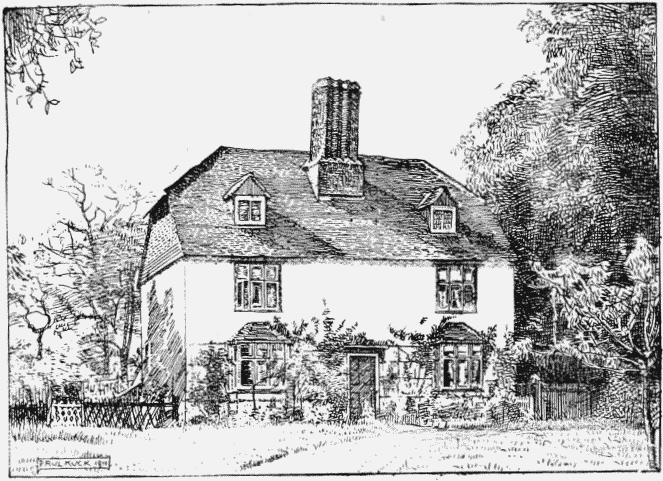
Bursteads: South-west Front
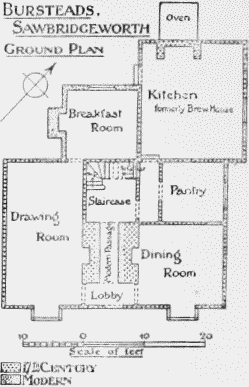
Bursteads Sawbridgeworth Ground Plan
The old manor-house, now used as a farm-house, which lies a little to the east of Trim's Green and is occupied by Mr. E. Stephens, is a small timberframed house covered with lath and plaster, the plaster work being decorated with basket-work pattern probably of the middle of the 17th century. The main gables are weatherboarded, the apex of each being slightly hipped. The roofs are tiled. The house consists of a main block measuring about 37 ft. long by 24 ft. 6 in. in depth and is of two stories with attics. A massive brick chimney occupies the centre of the building, dividing the interior into two rooms, one of which is now subdivided. The entrance door is in the middle of the front and opens into a small lobby the width of the brick substructure of the chimneys (about 9 ft.), through which, as at Berkhampstead School and Rectory Farm, Pirton, a modern passage has been tunnelled to the stair at the back. The two small bay windows in front are modern, but all the other windows have oak mullions and transoms.
Adjoining the house is a very large and lofty thatched barn, probably erected during the 17th century.
Blunts
The manor of BLUNTS originated in a grant of lands to Robert Blunt of London made by Warin Fitz Gerold (for whom see above under Pishobury) and confirmed by Geoffrey de Mandeville Earl of Essex, lord of the fee. (fn. 242) The names of John le Blunt, (fn. 243) who died before 1330, (fn. 244) Agnes his wife, (fn. 245) John (possibly their son), (fn. 246) who was living in 1341, Thomas, living in 1348, (fn. 247) and a Thomas, living in 1418, (fn. 248) occur in records of Sawbridgeworth. The services for their lands were owed in the 15th century to the lord of Mathams, to whom apparently they had been assigned at some earlier date by a lord of Pishobury. (fn. 249) Later the lands came either by escheat or purchase to the owners of Mathams. John Leventhorpe died seised in 1511 of the 'manor of Blunts,' and for a long time it descended with that manor (fn. 250) (q.v.). In 1861 it was bought by Mr. John Prout (see general description of parish) and now belongs to Mr. William Prout.
Other tenants of the lords of Pishobury and Mathams were the Vantorts, (fn. 251) whose holding in the 16th century is called the manor of VANTORTS. Margaret wife of Robert Vantort died in 1310 seised of lands in Sawbridgeworth, which descended to her son Thomas. (fn. 252) The name of Richard Vantort of Sawbridgeworth occurs in 1337 and 1348 (fn. 253) and of John Vantort in 1378 (fn. 254) and 1386. (fn. 255) A John Vantort was holding lands of John Leventhorpe of Mathams early in the 15th century. (fn. 256) In the 16th century the 'manor of Vantorts' was held with Mathams by the Leventhorpes (fn. 257) and subsequently became amalgamated with that manor. Vantorts Farm lies to the south-east of the town.
Bleches, Blaches, or Blotches
BLECHES, BLACHES, or BLOTCHES was the holding of a John Bleche, whose name appears in Sawbridgeworth at the end of the 14th century, (fn. 258) and who was living in 1404. (fn. 259) His lands, called the manor of Bleches, were held with Chamberlains (q.v.) in the 16th century by John Shelley. The estate descended with that manor until 1764, when it was sold by Christopher Parker the younger to raise money for paying off the mortgage on Chamberlains. (fn. 260) The purchaser was Edward Gardiner of Pishobury.
Freres
FRERES was similarly the holding of another local family. The name of Walter Frere occurs in 1220 (fn. 261) and of William Frere in 1278. (fn. 262) Another Walter Frere and Alice his wife held lands in Sawbridgeworth in the 14th century. (fn. 263) They had sons John (fn. 264) and Robert. (fn. 265) Robert and his wife Cecilia were conveying lands in 1379, (fn. 266) and a Robert and his wife Katherine were living in 1418. (fn. 267) The chief holding seems to have been that of Thomas Frere, whose name occurs about the middle of the 15th century. (fn. 268) He held the property called Freres Place. By his wife Cecilia (who afterwards married Hamelin de Matham and died in 1410) he had two daughters, Joan, who married John son of John Burman of Stainby, co. Lincoln, by whom she had a son John aged three in 1418 (fn. 269) (by which date she was dead), and Alice, who married first Denis Lopham and secondly John Rodenhale. (fn. 270) In 1481 John Lymbard granted the manor of Freres to John Browne and John Jocelyn, (fn. 271) but whether any of these were beneficiary owners is uncertain. The estate next appears in 1509, when Clement Cotton and Constance his wife conveyed to Thomas Laurence, (fn. 272) after which no further record of it has been found. It seems to be represented by the present Fryars in the west of the parish.
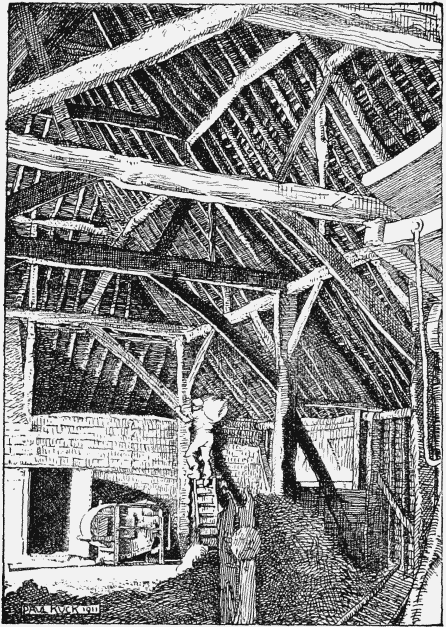
Bursteads: Interior of Great Barn
Actons
A reputed manor called ACTONS was held in the 16th century by the Leventhorpes. John Leventhorpe was in possession in 1561. (fn. 273) In 1564 Edward Leventhorpe conveyed it to Thomas Leventhorpe, (fn. 274) who was holding it in 1570, when he granted it to Oliver Lord St. John and others, (fn. 275) probably trustees in a sale. In February 1636–7 Sir John Fowle died seised of 'the manor or farm of Actons,' John, his eldest son, aged fourteen, being his heir. (fn. 276) This farm is situated on the west of the parish close to Fryars.
CHURCHES
St. Mary
The church of ST. MARY consists of chancel 44 ft. by 23 ft. 6 in., nave 58 ft. by 28 ft., north aisle 59 ft. by 11 ft. 6 in., south aisle (inclusive of south chapel) 73 ft. by 19 ft., south porch 12 ft. by 10 ft., west tower 19 ft. 6 in. by 17 ft.; all internal dimensions. The church is built of flint rubble with stone dressings, the chancel walls being coated with cement; the roofs are covered with lead.
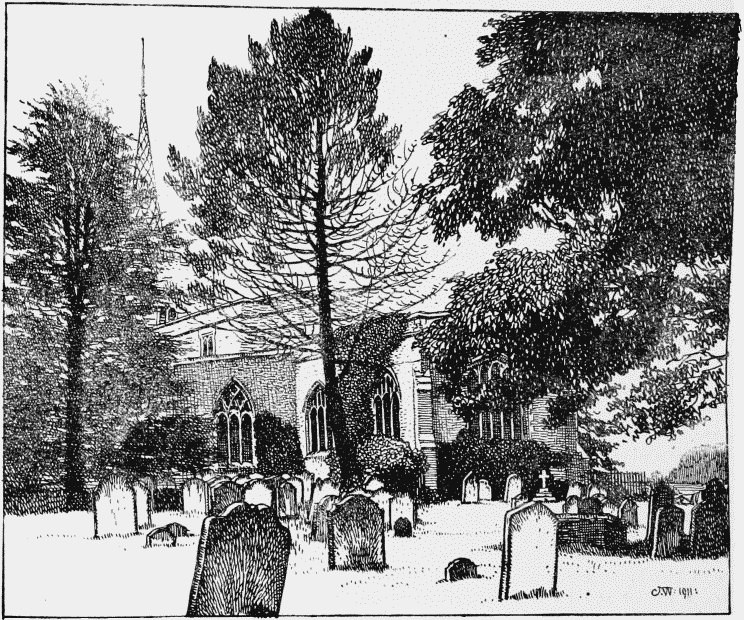
Sawbridgeworth Church from the South-east
It is probable that the main part of the chancel, nave and lower stage of the tower were built in the 13th century; the north and south aisles and the south chapel were added early in the 14th century; the clearstory was raised and the nave re-roofed in the 15th century, and probably about the same period the south porch was erected and the upper part of the tower built. In 1870 the whole church was repaired, much of the stonework renewed, and the chancel re-roofed.
In the east wall of the chancel is a large five-light window, one of two lights in the north wall, and two of three lights in the south are almost entirely of modern stonework. The partially blocked doorway on the north side is of 15th-century date, it probably opened into a vestry, now destroyed; the doorway has a four-centred arch with moulded jambs. The south chancel doorway is modern. At the west end of the south wall is a pointed arch of two richly-moulded orders, now blocked by the organ. The inner order is carried on moulded corbels; it is of about 1300. The chancel arch is of two splayed orders, with jambs of similar section; it is of 13th-century work, but the jambs, capitals and bases have been repaired.
The south chapel is used as a vestry, and is partly filled by the organ. The three-light east window is of modern stonework; in the south wall is a blocked window of 14th-century date. At the west end on the north side is the doorway to the rood stair; the upper doorway opens into the nave; the stair is partly blocked. The west end of the chapel opens into the south nave aisle without any structural division.
The nave has north and south arcades of three bays of pointed arches; the arches are of two moulded orders, with labels and head stops; the piers are of quatrefoil section and have moulded capitals and bases. The details of the two arcades differ, the north arcade being the richer, and is probably some twenty years earlier in date than the other. The clearstory windows are of two cinquefoiled arches under square heads, all of modern stonework. The roof is of 15th-century date, with moulded timbers and traceried spandrels, the trusses resting on carved stone corbels.
At the east end of the south wall of the north aisle is a recess, probably a piscina, with a cinquefoiled arch under a square head; it has been much renewed. The windows in the east and west walls of three cinquefoiled lights, and those in the north wall of two lights, have moulded internal jambs and rear-arches; they have geometrical tracery under pointed arches, which has been partly renewed. The north doorway with its moulded arch has been largely renewed. Both the windows and the doorway are of 14th-century date. To the east of the doorway, internally, is a recess with square bracket under.
The windows of the south aisle, with their tracery, are of modern stonework, but the internal jambs may be of 14th-century date. The south doorway is chiefly of early 14th-century date; the pointed arch is of three moulded orders; the moulded jambs appear to be earlier, and may be 13th-century work reset. The roofs of both aisles have moulded ribs and carved bosses, and are of 15th-century work; the spaces between the ribs are plastered. The trusses of the south aisle roof rest on carved stone corbels. To the east of the south doorway, internally, is a recess with cinquefoiled head and moulded jambs.
The stonework of the south porch is all modern, but it retains its 15th-century wooden roof.
The tower is of three stages without buttresses, and has an embattled parapet and a slender octagonal spire, lead covered, the lead ribs forming a lozengeshaped diaper pattern. On the south side is a projecting stair turret of brick, finished with an embattled parapet below the belfry stage; it was probably built in the 16th century. The tower arch is of two splayed continuous orders of 14th-century date; the stonework of the jambs has been renewed. The 14th-century west door is of two splayed continuous orders, with a moulded label, and has been repaired; the 15th-century window above has three cinquefoiled lights under a four-centred arch.
The second stage of the tower has on the north and the south face a single pointed light; the belfry stage has on each face a two-light window of the 15th century, repaired with cement.
The octagonal font dates from about 1400, and has been repaired; on each side of the basin is a quatrefoil within a square panel; on the stem are traceried panels.
The 15th-century oak rood screen consists of three wide bays with pointed arches in the upper part; these are subdivided and the heads traceried; the lower close panels are also traceried.
The south door is panelled, the upper parts being traceried; it has been repaired. It retains its old ironwork, and is probably of late 14th-century date. Near it is an oak poor-box dating from about 1600. Under the tower is a large oak chest with five locks, probably of the 17th century, and incorporated with some of the seating are some early 16th-century bench ends and other woodwork. The oak pulpit is carved and panelled, and is inscribed 'Christe is all in all. 1632.'
At the north-east corner of the chancel is a tomb with the recumbent effigies of John Jocelyn, 1525, and his wife Phyllis; he is in plate armour and his wife is dressed in a long robe; the figures are much defaced. On the same wall is a large classical monument, with the figure of George Viscount Hewett, who died 1689. On the south wall of the chancel is a late 15th-century marble tomb without an inscription; the lower part has traceried panels with shields from which the brasses have been taken; above is a richly carved and traceried canopy supported on engaged shafts carved with a lozengeshaped surface ornament. At the back, beneath the canopy, are indents of brasses of a man, his two wives and his children. In the south chapel is a large marble monument, with recumbent effigies of Sir John Leventhorpe, who died 1625, and his wife; they lie under a semicircular canopy with sculptured figures in the spandrels, and flanked by Corinthian columns supporting the cornice over which are his arms; kneeling figures of his fourteen children are in front.
On the east wall of the nave is a marble mural monument to Sir William Hewett, died 1637, and his wife, and under the tower is a monument to Sir Thomas Hewett, who died in 1662.
In the nave is a slab of Purbeck marble with an incised figure, apparently of a nun, probably of early 14th-century date, but the marginal inscription is illegible. Another slab in the nave bears the muchworn marginal inscription 'Hic jacet Thomas de Aungerville quondam Rector Ecclesie de Sabruchesworth, Non. Dec. 1333.
In the south aisle is a stone slab with an illegible inscription of the 14th century.
On the chancel floor is a brass of Geoffrey Jocelyn, 1470, with figures of himself and his two wives; part of the inscription is gone.
In the nave is a slab with indents of a man, his two wives and four shields, the remaining shield bears the arms of Chauncy; another slab with brasses of twelve sons and six daughters with arms quarterly 1 and 4, on a chief a lion passant, 2 and 3 a lion rampant debruised by a bend.
On the floor of the south chapel are figures of a knight and a lady, with the arms of France and England quartered. The figures are said to be John Leventhorpe and his wife, about 1433; there is no inscription. In the south aisle is a figure of a lady in a mantle; three shields and arms of Leventhorpe. There is an indent of a man and another shield, but no inscription, said to represent Thomas Leventhorpe, who died in 1527, and his wife Joan; a brass with figures of a man in armour and a lady in Elizabethan dress, and inscription to Edward Leventhorpe, died 1551, and his wife Elizabeth.
In the north aisle are brasses of two shields and an inscription to William Chauncy, probably of the 15th century.
Beneath the tower is the figure of Mary wife of Edward Leventhorpe, died in 1566, with inscription; also of a man and a woman in shrouds, with a shield of France and England, probably to John Leventhorpe, who died in 1484. In the south aisle is the indent of a woman of 15th-century date. Other brasses belonging to Sawbridgeworth Church are now in the museum of Saffron Walden.
There are nine bells: the treble and second by John Taylor, 1872; the third by Thomas Lester, 1749; the fourth, fifth, sixth and seventh recast by Taylor, 1870; the tenor by John Briant, 1795; a small bell not in the peal, 1664.
The communion plate consists of modern chalice, paten and flagon.
The registers of baptisms, marriages and burials begin in 1558.
St. James, High Wych
The church of ST. JAMES, HIGH WYCH, is a building of flint and stone in 13th-century style, consisting of chancel, nave of four bays, south aisle, south porch and south-west bell-turret.
ADVOWSONS
A priest is mentioned among Geoffrey de Mandeville's tenants in 1086, (fn. 277) showing that the church was appurtenant to the manor. The tithes were given by Geoffrey de Mandeville to the church of St. Mary of Hurley, co. Berks., endowed by him at the end of the reign of William I and granted to Westminster, to which church it formed a cell. (fn. 278) Early in the 12th century, probably while the manor was in the king's hands through a mortgage (see above), the church seems to have been granted by Henry I to Otwel Fitz Count (son of Hugh Earl of Chester), and after his death in the catastrophe of the White Ship in 1120 to have been given by the king to the abbey of Westminster. (fn. 279) After the Mandevilles had regained possession, Geoffrey the first Earl of Essex (ob. 1144) granted the church of Sawbridgeworth to the abbey of Walden as part of its endowment. (fn. 280) Geoffrey de Mandeville the younger and William his brother are said to have looked with little favour on the numerous grants of churches made by their father to this abbey, (fn. 281) and this probably accounts for a renewal of the grant to St. Peter's, Westminster, made by William Earl of Essex (ob. 1189). (fn. 282) By an agreement made between Richard Abbot of Westminster and Eustace Bishop of London (1221–9) the advowson is said to have been transferred to the Bishops of London, who were to make annual payments to the Abbots of Westminster and Walden for the tithes. (fn. 283) In 1258 the king, who claimed the presentation during the vacancy of the abbey of Westminster, brought an action against the Bishop of London, recovered seisin of the advowson, (fn. 284) and presented John Maunsel, treasurer of York. (fn. 285) In 1266 the abbey recovered the presentation against Henry Bishop of London by assize of darrein presentment. (fn. 286) Licence for appropriation was granted by the king in 1331, (fn. 287) a mandate from Pope John XXII to the Bishop of London to carry out the appropriation having been obtained the year before. (fn. 288) The Bishop of London refused to appropriate, as appears by a second mandate of 1333 (fn. 289) and also by a further renewal of the licence by Pope Clement VI in May 1351, the reason here given for the appropriation being that some of the abbey's houses had been burnt in the fire at the king's palace. (fn. 290) Apparently after the issue of these letters the abbey's proctor at the Roman Court renounced the abbey's right in favour of the Bishop of London, for in December of the same year the abbey agreed to pay the merchants of the society of Malbayl 800 florins if Sir Anthony Malbayl would obtain a renewal of the apostolic letters dated after the renunciation made by the abbey. (fn. 291) The appropriation seems to have been finally carried out in 1356, when a vicarage was ordained. (fn. 292) After the Dissolution the advowson was granted by Henry VIII to the Bishop of Westminster in 1541, (fn. 293) and by Edward VI, after the resignation of the Bishop of Westminster in 1550, to the Bishop of London, (fn. 294) with whom it remained until transferred to the see of Rochester in 1852. In 1877 it was again transferred to the Bishop of St. Albans, the present patron. (fn. 295)
The rectory was granted by Henry VIII in 1542 to the Dean and Chapter of Westminster, (fn. 296) and after the dissolution of the abbey, temporarily refounded by Mary, was confirmed to them by Elizabeth. (fn. 297) The Ecclesiastical Commissioners are now the lay rectors.
View of frankpledge was held by the parsons of Sawbridgeworth (previous to the appropriation) for their tenants in the parish, (fn. 298) and courts were held by the abbey of Westminster for the rectory lands as late as the 15th century. (fn. 299) In 1651 the trustees for the sale of church lands sold the parsonage-house to Patrick Carey with the site containing about 3½ acres, other lands including the Great and Little Orchard and Upper and Nether Stockwell, the first abutting on Parsonage Lane and the second on the field called Tedenhambury. These had been leased out by the dean and chapter. (fn. 300) A survey of the rectory taken in 1773 mentions the house with two barns, two stables, a cowhouse, a carthouse, a granary, a dovehouse and a large garden and field, also 118 acres of land and 14 acres in the common fields. (fn. 301) By an agreement with the tenant in 1791 the coalhouse, pantry and granary were to be taken down, the dairy, woodhouse, and barn rebuilt, and the parlour, brewhouse, servants' hall and the room above it to be repaired and tiled. (fn. 302) The moated house called Parsonage Farm, which has been recently pulled down, was situated a little to the north of the town. There is still a very large tithe barn with fine timbers in the roof. The thatched roof was replaced by a slate one a few years ago.
By the composition made in 1356 (see above) the vicar of Sawbridgeworth received a part of the revenues of the church, which then amounted to 43 marks yearly. For a long time the endowment was sufficient even for a cure of the size of Sawbridgeworth, and the vicars 'did not all only keep good hospitality, but also did so apply themselves to learning that they were able and did sufficiently do their duty.' A great part of their income was derived from the tithe paid for the saffron then grown in large quantities in the parish, but by the beginning of the 16th century the cultivation of saffron had been given up and the land used for corn; consequently the vicars' stipend had so decreased that they had to borrow from their parishioners and run into debt. (fn. 303) Matters were not much improved by 1704 when the vicar (Charles Pole) complained that the small tithes did not afford subsistence for himself and his family. (fn. 304)
In 1352 William Basset of Stowe St. Edward, parson of Toppesfield, had licence to grant a messuage in Sawbridgeworth to William de Stowe, parson of the church there, as a residence for two chaplains who were to celebrate in the church. (fn. 305) This was probably in connexion with a chantry.
The living of St. James, High Wych, is a vicarage in the gift of the vicar of Sawbridgeworth.
CHARITIES
The Sawbridgeworth United Charities are regulated by a scheme of the Charity Commissioners dated 6 March 1908. They comprise:—
1. The Church and Poor Lands (exclusive of the Sawbridgeworth Ecclesiastical Charity) comprised in an indenture dated 20 July 1652. The endowment consists of a moiety of the income derived from the following property:—
The bowling green, containing 3 r. 22 p., used as a recreation ground for boys;
Three cottages occupied as almshouses by three poor women who receive parochial relief;
Pishocroft Gardens, containing about 5 acres, near High Wych, let in allotments and producing about £9 10s.;
And a sum of £720 14s. 5d. consols in the name of the official trustees, producing £18 0s. 4d. yearly, arising from the sale in 1898 of a rood of land in Church Street, with the dwelling-house and school buildings thereon. The net income is distributed to the poor.
2. Charity of John Salmon for the poor, founded by will dated in 1729, whereby a yearly rent-charge of 20s. issuing out of a croft called Little Hempsall was devised for distribution in sums of 2s. at Christmas to ten poor families.
3. Charity of Richard King, founded by will dated in 1748, whereby a rent-charge of £1 issuing out of a messuage and land in Sawbridgeworth was devised to be distributed to twenty poor widows.
The Sawbridgeworth Ecclesiastical Charity.
— By an Order of the Board of Charity Commissioners dated 17 March 1896 a moiety of the net income of the Church and Poor Lands was severed from the rest of the endowment and called the Sawbridgeworth Ecclesiastical Charity. The income is applied to church expenses.
John Salmon also devised a sum of £1 yearly, issuing out of the croft called Little Hempsall, for beautifying and ornamenting the church. This sum is carried to the Church Expense Fund.
In 1811 Mr. Orchard gave a sum of £25 stock, now represented by £25 consols with the official trustees, producing 12s. 4d. yearly, which sum is paid to the oldest widow in the parish.
In 1864 Daniel Brown, by will proved at London 5 May, gave £100 stock, the interest to be applied in keeping in repair the tomb of testator's family in the churchyard and any residue to be distributed to the poor on the first Sunday after Christmas Day. The dividends on the endowment amount to £2 5s. yearly.
In 1910 £1 7s. 6d. was spent in repairs to the tomb and twenty-six old people received 2s. each.
In 1895 Miss Frances Lane, by her will proved 8 October, gave £300 to be applied, so soon as land should be given for the purpose, in building and endowing an almshouse or almshouses for the benefit of married couples of sixty years and upwards. The legacy, less duty, was invested in consols, and the dividends are being invested in consols in augmentation of the principal sum, which in May 1909 amounted to £341 7s. 4d., in the names of the Rev. H. A. Lipscombe and two others.
The same testatrix bequeathed £100, the income arising therefrom to be applied in keeping the family tomb in the churchyard in repair, and any residue to be distributed to the poor; also a further sum of £100 to the Sunday school. These legacies, less duty, were invested in £161 11s. 5d. consols, producing £4 0s. 8d. yearly. In 1910 a sum of 18s. 9d. was spent in repairs to the tomb, £1 1s. 7d. was carried to the Sick and Needy Fund, and £2 0s. 4d. was paid to the treasurer of the Sunday school.
The same donor by her will also bequeathed a sum of money, the interest arising therefrom to be applied at the discretion of the vicar for the good of the district of Spelbrook. The legacy was invested in New Zealand 3½ per cent. Inscribed Stock, producing £14 6s. yearly in dividends. One moiety of this amount is applied to church expenses and the other to the church school.